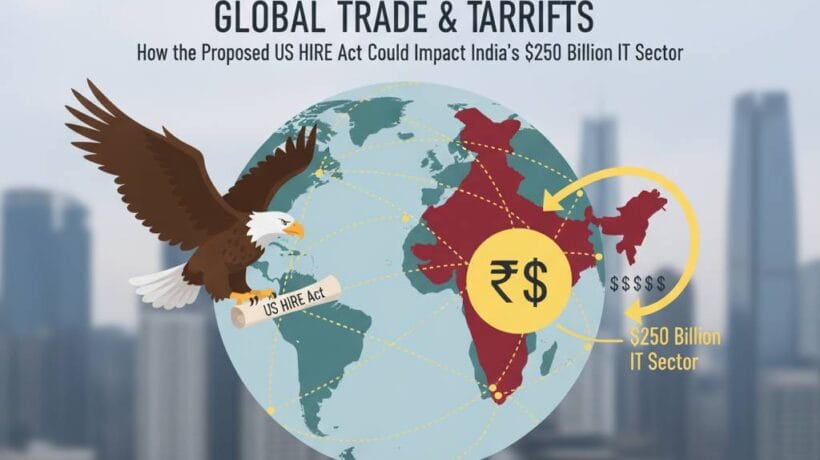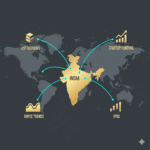Global Trade & Tariffs: How the Proposed US HIRE Act Could Impact India’s $250 Billion IT Sector
Introduction
Global trade policies and tariff structures significantly influence the growth of international businesses. Recently, the US HIRE Act (Help In Recruiting Employees Act) has sparked discussions in financial and business circles. If passed, this legislation could impose a 25% tax on payments to foreign IT firms, directly impacting India’s IT services industry—currently valued at USD 250 billion. While the bill is still under consideration, its potential implications for India’s economy, jobs, and global competitiveness are worth examining.
What is the US HIRE Act?
The proposed HIRE Act is aimed at boosting domestic employment in the US by incentivizing companies to hire locally rather than outsourcing jobs overseas. A key provision suggests imposing a 25% withholding tax on payments made to foreign IT service providers.
This move is positioned as a way to reduce reliance on outsourcing and retain high-paying tech jobs within the US.
Why Does It Matter for India?
India is one of the largest exporters of IT services to the US, with companies like Infosys, TCS, Wipro, and HCL deeply integrated into American business operations. The US accounts for nearly 60% of India’s IT export revenue, making this proposed tariff a major concern.
Key Impacts If Passed:
Revenue Pressure: A 25% tax would either reduce client spending on Indian IT firms or force companies to absorb the cost, cutting into margins.
Competitiveness: US clients may reconsider outsourcing contracts and shift to local providers or alternative low-cost markets.
Employment in India: With reduced project volumes, hiring in India’s IT sector may slow down, impacting jobs and freshers.
Currency & Trade Balance: Any slowdown in IT exports could weaken India’s services trade surplus, which supports the rupee and balances imports.
Global Trade & Tariffs: The Bigger Picture
This development highlights the growing protectionist trend in global trade. Countries are increasingly focusing on domestic job creation, often by imposing tariffs or restrictive policies.
For India, this means:
Diversification is key: Expanding IT exports beyond the US to Europe, APAC, and emerging markets.
Value-driven innovation: Moving up the value chain in AI, cloud, cybersecurity, and digital transformation services.
- Diplomatic engagement: India may need to negotiate with US lawmakers to protect its IT sector under trade partnerships.
Conclusion
The proposed US HIRE Act is not law yet, but it signals the challenges of a protectionist global trade environment. India’s IT sector must prepare for possible changes by diversifying markets, strengthening innovation, and advocating through diplomatic and trade channels. While the USD 250 billion IT industry remains resilient, vigilance and adaptability will be essential to sustain growth in an increasingly tariff-driven world.
FAQ'S
Q1. What is the US HIRE Act?
The HIRE Act is a proposed US bill that seeks to impose a 25% tax on payments to foreign IT firms, encouraging local hiring and reducing outsourcing.
Q2. Has the US HIRE Act been passed?
No, the bill has been proposed but not yet passed. It is under discussion in the US legislature.
Q3. Why is India concerned about this Act?
India’s IT industry earns nearly 60% of its revenue from US clients. A 25% tax could reduce outsourcing demand, affecting revenues, jobs, and exports.
Q4. How much is India’s IT industry worth?
India’s IT and business process management (BPM) industry is valued at USD 250 billion (2024), making it one of the largest in the world.
Q5. Will this Act only affect IT companies?
Primarily, yes. The Act targets IT service outsourcing. However, its ripple effect could extend to consulting, business process outsourcing, and related services.
Q6. What can Indian IT firms do to reduce risk?
They can diversify client geographies, invest in high-value services like AI and cybersecurity, and collaborate more with local talent in the US.
Q7. How does this impact global trade relations?
It highlights a shift towards protectionism. Such tariffs may strain trade ties between India and the US, requiring negotiations at the government level.





